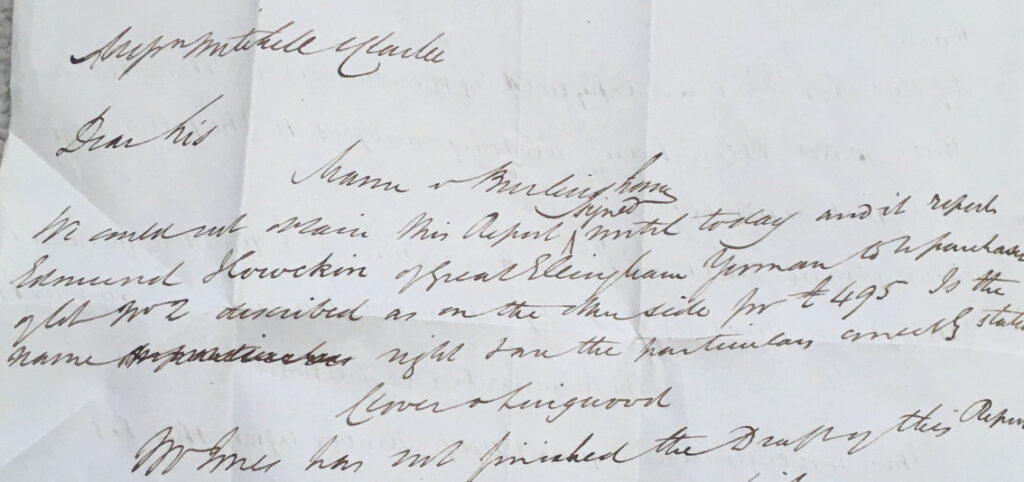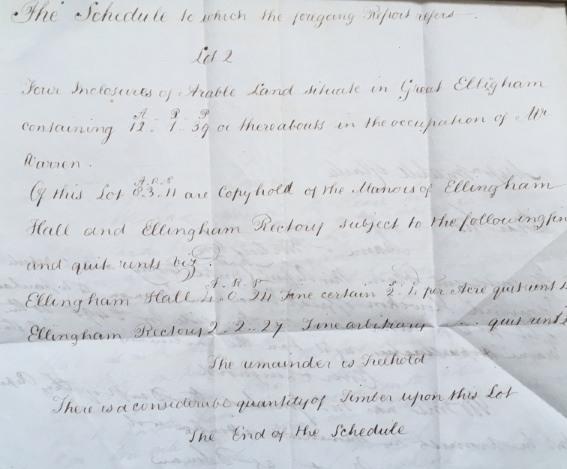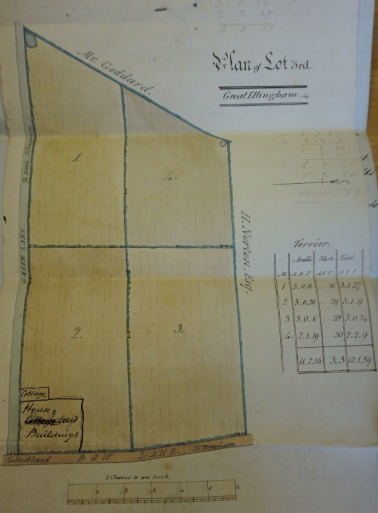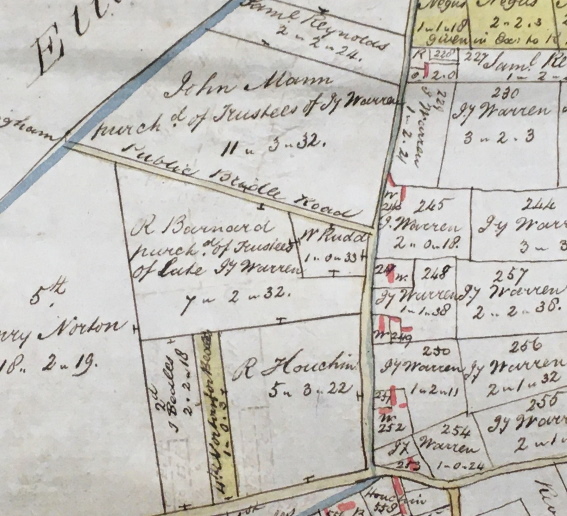

Extracts from a letter dated 3rd March 1840
to Messrs Mitchell & Clarke Wymondham from Trehern & White of 134 Leadenhall Street London
Author’s own collection
The above letter dated 3rd March, 1840, was sent by Messrs Trehern & White of London to Messrs Mitchell & Clarke solicitors of Wymondham. Under the heading ‘Mann & Burlingham’, the writer refers to ‘Edmund Howckin of Great Ellingham Yeoman’ and his ‘purchase of lot No.2 described as on the other side for £495’.

Schedule included with letter dated 3rd March 1840
to Messrs Mitchell & Clarke Wymondham from Trehern & White of 134 Leadenhall Street London.
Author’s own collection
The ‘other side’ referred to in the letter, is a Schedule which provides a description of the land comprised in ‘lot No.2’.
Edmund Houchen purchased four inclosures of arable land (which together totalled twelve acres one rood and thirty nine perches) in Great Ellingham. Just over four acres of the land was copyhold of the Manor of Ellingham Hall, with around two acres copyhold of the Manor of Ellingham Rectory and the remainder was freehold.
Who was the Seller of the Land to Edmund Houchen?
A Notice referring to a Decree of the High Court of Chancery, made in the case of Mann v Burlingham, appeared in the London Gazette dated 9th March 1841. ‘Mann & Burlingham’ is referred to in letter of 3rd March 1840, sent to Wymondham solicitors Mitchell & Clarke, concerning the land purchased by Edmund Houchen.
Creditors of the late John Mann (who had died in December, 1818) were being requested to prove their debts before the Masters of the High Court of Chancery, before the 3rd April, 1841.
In his Will, John Mann had appointed farmers Edward Mann of North Tuddenham, John Burlingham of Old Buckenham and Garrett Taylor of Deopham as his executors.
Given that John Mann had died over 20 years before the Notice advertising for Creditors appeared in the Gazette, the court case may well have delayed the sale of the late John Mann’s assets and the subsequent winding up of the Estate.
Perhaps there was a dispute concerning the content of John Mann’s Will and/or a disagreement between two of the executors, Burlingham and Mann? It is also possible that a beneficiary had a life interest in John Mann’s estate which may have delayed the sale of John Mann’s assets. However, any investigations around the will and estate of John Mann will have to wait until another day!
Where was the Land?
In the meantime and turning to the land, a schedule of the Great Ellingham Estates relating to the tithes payable (and created no later than around 1840), indicate that amongst other land, John Mann’s Executors held four Common Allotments on Anchor Common namely ‘Pooleys Three Acres’, ‘Pooleys Two Acres’, ‘Pooleys next the Bridleway’ and ‘Pooleys next Bridleway and Private Road’.
I was able to identify all four allotments held by John Mann’s Executors in a Particular Survey of the Parish of Great Ellingham dated 1817-1819.

Plan to the Great Ellingham Inclosure Award to John Mann of 1st May 1802. Courtesy of Wymondham Town Archive
The above plan shows the allotments awarded to John Mann by the Commissioners acting under the Great Ellingham Inclosure Act dated 1st May 1802.
Given that ‘re Houchen‘ is written on the back page of the document, I believe that the Extract was produced to prove John Mann’s ownership of the land at the time of Edmund Houchen’s purchase in 1840.
This map also indicates the position of a cottage, house and buildings on the allotment numbered 2. These drawings appear to have been added to the map at a later date.
Whilst the Tithe Map of c1840 shows a building in the same corner of the field, by the time the First Edition of the Ordnance Survey Map (1879-1886) was published, the building had disappeared.

Extract from 1802 Map of Great Ellingham. Original held at Norfolk Record Office. Russell James Colman Plans. Cat. Ref. C/Ca 1/84. With kind permission of NRO
The above extract from an 1802 map clearly shows the area of the four allotments on Anchor Common, as one parcel of land. Bow Street (or Bow Lane) is shown by the vertical line with the road from Great Ellingham to Rocklands running along the bottom of the map. This map also tells us that John Mann had purchased the land from the Trustees of the late Jeffrey Warren.
The 1841 census captures 55 year old farmer Edmund Houchen with his wife Mary (also 55) and sons John and Stephen living in Bow Street. I wonder whether the Houchen family were occupying the house and/or cottage drawn on the Plan to the Great Ellingham Inclosure Award to John Mann of 1st May 1802?
Sources:
3rd March 1840 Letter to Messrs Mitchell & Clarke Wymondham from Trehern & White of 134 Leadenhall Street London. Author’s own collection
The London Gazette 9 March 1841 Issue 19959 Page 646. https://www.thegazette.co.uk/London/issue/19959/page/646. Accessed 29/06/2020
Mann, John, of Great Ellingham. Norfolk Record Office. ANF will register 1819-1820 fo. 326 (1819 no.75). Viewed via http://www.norfolksources.norfolk.gov.uk 29.06.2020
1841 census HO107/781/8
Extract of Enclosure Award of Great Ellingham with plan of alllotment to John Mann. Wymondham Town Archive. ID251. 01.05.1802. Box 26/23. Bundle 1. Wymondham Town Archive, 14 Middleton Street, Wymondham NR18 0AD
1802 Great Ellingham. Russell James Colman Plans. Norfolk Record Office. Catalogue Ref. C/Ca 1/84.
F.W. Horner, Records of the Surveyors to Commissioners for Inclosure in Parishes in Norfolk and Suffolk. Great Ellingham (Act 1799). 1799-1842. Norfolk Record Office. Catalogue Ref. BR 90/2
First Edition Ordnance Survey Map. Norfolk. Between 1879 and 1886. Tithe Maps of Norfolk c.1840. http://www.historic-maps.norfolk.gov.uk/ Accessed 29.06.2020